

Oil Spills: Impact on the Ocean - sea, effects, temperature, percentage, important, largest, types, source, marine, oxygen, human. A Deadly Toll. The BP Deepwater Horizon catastrophe in 2010 spilled 205.8 million gallons of oil and 225,000 tons of methane into the Gulf of Mexico.

Navy Dumped Thousands of Tons of Radioactive Waste Into the Atlantic Ocean. 8 Million Metric Tons of Plastic Dumped Into World's Oceans Each Year. We’ve been hearing for years about all the plastic that is going into our oceans, creating enormous gyres, washing up on beaches, threatening marine life and marine ecosystems in ways we don’t even know yet.

A study last year called Valuing Plastic by the Plastic Disclosure Project and Trucost, estimated plastic caused about $13 billion in damages to marine ecosystems each year—and noted that that estimate was probably low, given what we don’t know yet. Tracking all of that plastic, which ranges from plastic bags and bottles to tiny microbeads of plastic broken down from larger sources, has been an ongoing challenge for scientists. With each new study, we get a little closer to figuring out just how much there might be out there—and it’s worse than we thought. “Population size and the quality of waste management systems largely determine which countries contribute the greatest mass of uncaptured waste available to become plastic marine debris,” said the researchers.
Causes and Effects of Ocean Pollution - Conserve Energy Future. Oceans are the largest water bodies on the planet Earth.
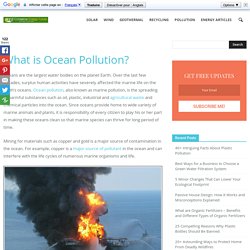
Over the last few decades, surplus human activities have severely affected the marine life on the Earth’s oceans. Ocean pollution, also known as marine pollution, is the spreading of harmful substances such as oil, plastic, industrial and agricultural waste and chemical particles into the ocean. Since oceans provide home to wide variety of marine animals and plants, it is responsibility of every citizen to play his or her part in making these oceans clean so that marine species can thrive for long period of time.
Mining for materials such as copper and gold is a major source of contamination in the ocean. The world's largest 'waste dump' is found in the Pacific Ocean. If you were to travel from the United States of America to Japan, you would most likely encounter what could be described as the worl''s largest waste dump: a 100,000 tonne expanse of debris floating around a large region of the Pacific Ocean.
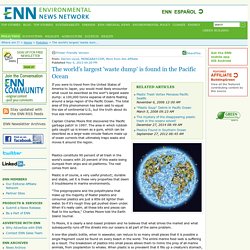
The total area of this phenomenon has been said to equal the size of continental U.S., but the truth about its true size remains unknown. Captain Charles Moore first discovered the 'Pacific garbage patch' in 1997. The area in which rubbish gets caught up is known as a gyre, which can be described as a large-scale circular feature made up of ocean currents that ultimately traps waste and moves it around the region. Plastics constitute 90 percent of all trash in the world's oceans with 20 percent of this waste being dumped from ships and oil platforms. The rest comes from land. Plastic is of course, a very useful product; durable and stable, yet it is these very properties that deem it troublesome in marine environments.
Read More at Mongobay.com. Dumping wastes at sea. Australia regulates the deliberate loading and dumping of waste at sea under the Environment Protection (Sea Dumping) Act 1981.
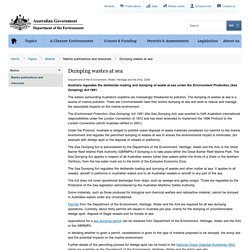
The waters surrounding Australia's coastline are increasingly threatened by pollution. The dumping of wastes at sea is a source of marine pollution. There are Commonwealth laws that control dumping at sea and work to reduce and manage the associated impacts on the marine environment. The Environment Protection (Sea Dumping) Act 1981 (the Sea Dumping Act) was enacted to fulfil Australia's international responsibilities under the London Convention of 1972 and has been amended to implement the 1996 Protocol to the London Convention (which Australia ratified in 2001). Ocean Dumping - water, effects, environmental, pollutants, United States, types, impact, EPA, chemicals, industrial, liquid, toxic, world, human, sources, disposal, use, life. Photo by: Tupungato Ocean disposal of society's waste got its start indirectly long before the Agricultural Age when nearby streams, lakes, and estuaries were useful as waste repositories.
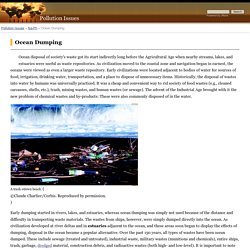
As civilization moved to the coastal zone and navigation began in earnest, the oceans were viewed as even a larger waste repository. Early civilizations were located adjacent to bodies of water for sources of food, irrigation, drinking water, transportation, and a place to dispose of unnecessary items. Historically, the disposal of wastes into water by humans was universally practiced. It was a cheap and convenient way to rid society of food wastes (e.g., cleaned carcasses, shells, etc.), trash, mining wastes, and human wastes (or sewage).
A trash-strewn beach ©Claude Charlier/Corbis. Effects of dumping radioactive waste in ocean need more study, scientists say. Dumping radioactive waste into the world's seas began in 1946 with a scientific argument whose foundation was the vastness of the oceans.
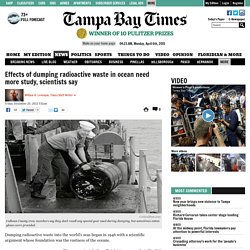
"It was no stretch (for officials) to assume that, like fish stocks, the ocean would rejuvenate itself through dilution, and that it had a definable annual capacity to do so for radioactive waste," Jacob Darwin Hamblin wrote in Poison in the Well, a history of dumping during the Cold War. What was true in the 1940s is true today — some mainstream scientists argue the oceans can absorb and disperse radiation so that it is harmless.
But few argue that the ocean is a good place for radioactive waste. Some scientists say radioactivity from dumps can make its way into the marine food chain. The barrels of radioactive waste dumped by the U.S.S. It didn't help that the Navy shot "floaters" – barrels that sometimes would sink only after taking rifle shots or, at least once, a strafing by military aircraft. But some scientists aren't convinced.